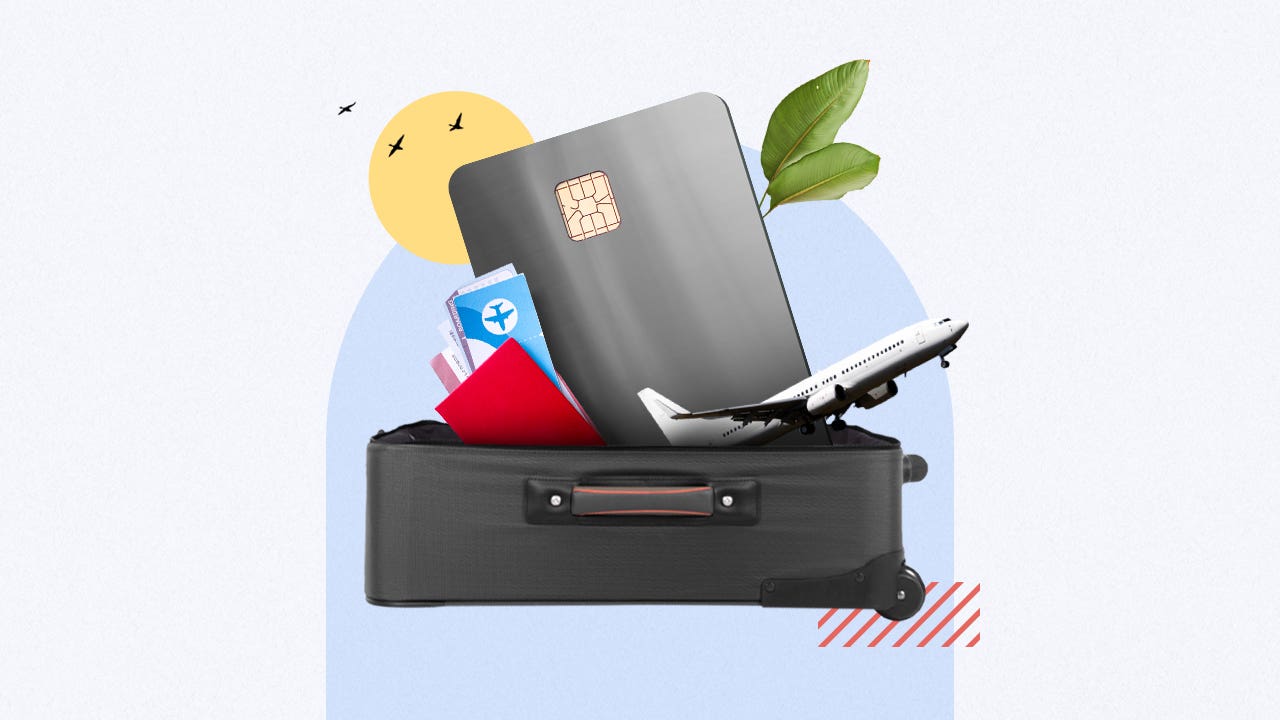How do travel credit cards work?

The Bankrate promise
At Bankrate we strive to help you make smarter financial decisions. While we adhere to strict , this post may contain references to products from our partners. Here's an explanation for . The content on this page is accurate as of the posting date; however, some of the offers mentioned may have expired. Terms apply to the offers listed on this page. Any opinions, analyses, reviews or recommendations expressed in this article are those of the author’s alone, and have not been reviewed, approved or otherwise endorsed by any card issuer.
Key takeaways
- A travel credit card offers points or miles for the purchases you make with the card that you can redeem for future travel.
- Travel credit cards come in all shapes and sizes, from co-branded hotel or airline cards to general travel cards that allow points and miles transfers to partner brands.
- In terms of redemption, you'll typically get the most value by redeeming toward travel in your issuer's portal or by transferring rewards to hotel and airline loyalty programs.
- Before applying for a travel card, consider its fees, ongoing rewards structure and first-year welcome bonus opportunity.
Travel credit cards make it easy to earn rewards — usually offered in the form of points or miles — for certain types of purchases. You can typically redeem your travel rewards for the big expenses associated with your next trip such as flights, hotels, car rentals and vacation packages. Some issuers also let you redeem travel rewards for statement credits and other non-travel options.
Some travel credit cards are associated with a specific airline or hotel loyalty program, whereas others let you earn rewards within a credit card’s rewards program. At the end of the day, you’ll want to understand the type of travel rewards your card offers, as well as available redemption options before you sign up.
Regardless of which type of card you choose, becoming a savvy travel rewards credit card holder can help offset travel costs and enhance your overall travel experience.
Types of travel credit cards
No matter your spending habits and rewards preferences, there’s likely a travel credit card that fits. Top travel credit cards include flexible rewards cards and those that are co-branded with another program, such as hotel credit cards and airline credit cards.
-
Flexible travel cards offer a wide range of options. These cards typically earn rewards points within a credit card issuer’s own rewards ecosystem as opposed to an airline or hotel’s loyalty program. Though options may vary by card, you can usually redeem your rewards for travel through a portal or transfer points to an array of partner airline and hotel programs. The flexibility makes them a good fit for cardholders who don’t have allegiance to any particular airline or hotel chain. General travel credit cards can also come with some pretty nice benefits, which may include airport lounge access or travel insurance protections.
Some examples of flexible credit card rewards programs or points currencies include American Express Membership Rewards, Capital One miles and Chase Ultimate Rewards, all of which have their own selection of cards for consumers and businesses.The Capital One Venture X Rewards Credit Card is one example of a flexible travel rewards card. It earns 10X miles on hotel and rental cars booked through Capital One Travel, 5X miles on flights booked through Capital One Travel and 2X miles on all other purchases. Those rewards can be redeemed through the Capital One Travel portal or transferred to one of Capital One’s travel partners. -
Co-branded hotel credit cards involve a partnership between a credit card issuer and a particular hotel chain. These cards typically earn a high rewards rate for booking hotel stays with the brand’s portfolio, and the points you earn can be redeemed for hotel stays, room upgrades and other hotel-related perks.
For example, the Marriott Bonvoy Brilliant® American Express® Card earns 6X Marriott Bonvoy points on eligible purchases at hotels participating in the Marriott Bonvoy® program, 3X points at restaurants worldwide and on flights booked directly with airlines as well as 2X points on all other eligible purchases. You can redeem points for future stays at Marriott properties or for purchases with the brand and its partners.
Many hotel credit cards offer automatic elite status (with higher annual fee cards typically granting higher status), as well as perks like early check in, late check out or free anniversary nights for cardholders. -
Airline credit cards are also considered co-branded since they let you earn rewards within a specific frequent flyer program. An example of a co-branded airline card is the Delta SkyMiles® Gold American Express Card, which earns 2X miles at restaurants worldwide (including takeout and delivery in the U.S.), U.S. supermarkets and on purchases made directly with Delta and 1X miles on all other purchases.
When you sign up for a co-branded airline credit card, you can redeem the miles that you earn for flights, cabin upgrades and other airfare-related purchases, like lounge membership. Some programs offer non-airfare-related redemption options like hotels or vacation packages, though these typically provide worse value than redeeming points for an award flight. Other benefits of airline credit cards can include free checked bags and priority boarding. If you travel with a specific airline more than once per year, the added perks to your trips could make it worth your while.
How to redeem points and miles
Once you’ve met the requirements for a hefty welcome offer or earned enough miles to cover your next flight or hotel stay, how do you redeem them? The kind of travel card you have and its respective rewards program determine how you can apply those rewards. If you have a hotel or airline credit card, you can typically only redeem those points with their respective loyalty programs, with a few exceptions. However, there are more ways to redeem flexible travel rewards, like booking through your card issuer’s online travel portal or transferring your points or miles to an issuer’s travel partners.
Redeeming rewards on an issuer’s online portal
Your card issuer will typically have a portal on its website that lists redemption options and points values. Examples of redemption options include statement credits, travel purchases, gift cards and cash back.
Rewards programs typically use a 1 point:1 cent conversion rate, meaning every 100 points or miles is worth $1. Some issuers, like Chase, also offer boosted points values or other perks for travel purchases made through their online portal. To get an idea of how much your points and miles are worth, take a look at Bankrate’s points and miles valuations page for an in-depth look at airline, hotel and credit card program rewards values.
To redeem your rewards on an issuer’s online portal, simply log in to your account and locate the appropriate rewards or travel section.
Redeeming rewards by transferring to a travel partner
Some travel rewards cards let you transfer points or miles to the issuer’s travel partners, which may include frequent flyer programs or hotel loyalty programs. This is often how to get the most value out of your travel rewards.
You can redeem travel rewards by transferring to an eligible travel partner through the issuer’s online portal. Transfer times can range from instantly to a few days — so plan ahead. Note, once you transfer points or miles from an issuer to a travel partner, you won’t be able to transfer them back to the issuer.
After you’ve transferred your points, you can book travel directly through the airline or hotel’s own loyalty program. Your credit card issuer is no longer involved in the process.
Other ways to redeem points and miles
Some credit cards allow you to redeem your points and miles for things like statement credits, cash back, gift cards or other merchandise. This is usually the least valuable way to redeem your points and miles so you’d be better off using them towards travel most times.
What’s the best way to maximize travel rewards?
When you want to make the most of your rewards, there’s no shortage of ways to spend a stockpile of points or miles. But here are some of the best ways to use your travel rewards:
- Book luxury accommodations
- Cover or lower the cost of your next flight
- Reserve a rental car at your destination
- Upgrade a flight or hotel stay
Be sure to check your card issuer’s online portal and travel partners for deals — such as a travel portal redemption bonus or transfer bonus to a specific hotel or airline — to help stretch your rewards further. In many cases, you can also choose to exchange your travel rewards for cash or a statement credit. But keep in mind that doing so usually dilutes the value of those rewards. Once you get the hang of using your travel credit card, you can maximize those rewards on bigger, better travel plans.
In general, the best value for flexible travel rewards will come from transferring them to various loyalty programs. For instance, the Chase Sapphire Preferred® Card’s rewards points are worth 1 cent each when redeemed for cash back, 1.25 cents each when redeemed for travel through the Chase Travel portal and 2 cents each on average when transferred to a travel partner (according to Bankrate’s valuations).
However, the value you get out of transferring points ultimately depends on how you redeem them. If you transfer 10,000 points from your travel credit card to an airline partner to book a flight that would’ve cost $300 in cash, your points would be worth 3 cents apiece in this case. However, if you used those same points to book a flight worth $100, your points would only be worth 1 cent apiece.
How to maximize your travel rewards
As we’ve mentioned, the best way to redeem points or miles is to transfer your rewards to one of the issuer’s airline or hotel partners and redeem them for accommodations or airline tickets. But making good use of a travel rewards card is about more than just earning and redeeming rewards — it’s also about managing the card itself well.
Whether you’re trying to get the best possible redemption value or want to know which pitfalls to avoid, here are a few tips to help you get the most out of your travel rewards.
Use your card responsibly
The most important rule of using a travel credit card is to always pay your bill on time and in full and never carry a balance if you can help it. To do this, make sure you never charge more than you can afford to pay off each month, and don’t let the prospect of rewards cause you to overspend. Credit card rewards aren’t worthwhile if you’re going into debt or racking up interest charges and fees to get them.
Don’t miss out on a sign-up bonus
Many travel credit cards come with generous sign-up bonuses requiring you to spend a certain amount within the first few months of opening the account. Although these bonuses are often an attractive incentive to apply for a card, make sure the spending requirement is realistic for your budget and travel plans before you choose a travel credit card. You don’t want to end up in debt for the sake of earning extra rewards.
Don’t ignore the card’s fees
Credit card fees don’t directly affect the rewards you earn, but the cost of the fees does affect a card’s overall value to you. Take note of all the fees associated with any card you’re interested in getting.
One of the biggest fees to watch out for with travel credit cards is the annual fee some cards charge. Not all travel cards come with an annual fee, but those that do can range from an approachable $95 to $695 (or more). If you’re interested in a travel card that has an annual fee, be sure that the rewards and benefits will offset the cost. Otherwise, consider our list of the best travel credit cards with no annual fee.
Watch out for foreign transaction fees
Some credit cards charge a foreign transaction fee for purchases made abroad or in a foreign currency. This fee is usually around 3 percent of a purchase, and you’ll pay this fee for every transaction you make overseas. If you travel abroad frequently, you should consider getting a credit card with no foreign transaction fees.
Luckily, many of the best travel rewards cards don’t charge foreign transaction fees, but it’s always a good idea to verify that before applying.
Make sure you have the right card
It’s important to find the right travel card for your needs, which you can do after comparing options and considering all their pros and cons. For example, if you’re partial to a certain airline or hotel chain, a co-branded credit card can offer better rewards rates, discounts and perks related to that specific airline or hotel compared to a generic travel card.
Additionally, pay attention to a travel credit card’s rewards categories. For example, earning points or miles at restaurants won’t deliver a lot of value if you rarely dine out. But if you use services like Lyft or Uber a lot, you may want to look into a card that offers points or miles for rideshares.
How to choose a travel rewards card
Choosing the right travel rewards card is a highly personalized decision. Ultimately your spending habits, goals, finances and credit history will determine which travel card works best for you. This may require some self-reflection and an assessment of your financial situation to find the right travel card. Review these factors in your financial life to get clear on which travel card you need:
- Travel preferences. Do you prefer using one specific airline or hotel chain when you travel? Or would you rather have the freedom to use your points on whichever hotel and flight you choose? For loyalty-based rewards, go for a co-branded travel card. If you prefer flexibility, generic travel cards will give you more options.
- Spending habits. What do you spend the most money on? One of the best ways to choose a travel card is finding one that offers the highest rewards for the categories you spend the most in.
- Welcome offers. You may find welcome offers for travel credit cards where you can earn extra rewards by meeting purchase requirements within a certain timeframe. As long as you’re able to comfortably meet the spending requirements, a bonus offer could be a deciding factor.
- Credit history. Like most credit cards, applying for a travel rewards card means a hard credit check to determine eligibility. If you know where your credit score stands, it’s best to choose travel rewards cards that fit your credit profile to avoid unnecessary denials and credit inquiries. For cards that match your credit, use Bankrate’s CardMatch™ tool.
- Annual fee. There are plenty of travel credit cards with no annual fee if that’s what works for your budget. However, some cards with annual fees are worth it thanks to extra perks and benefits.
Travel rewards cards for beginners
When you’re ready to earn rewards, it’s best to start with a beginner-friendly travel card so you can get the hang of things. Here are our picks for beginner travel rewards credit cards:
- Discover it® Miles. Earn unlimited 1.5X miles on all of your purchases without an annual fee. With a simple rewards structure and a mile-for-mile match on all of the miles you earn at the end of your first year, you’ll find plenty of ways to make the most of this flexible travel rewards card.
- Capital One Venture Rewards Credit Card. Get flexible travel rewards that are easy to use and understand, for a modest $95 annual fee. Earn 2X miles on all purchases and 5X the miles on hotels and rental cars booked through the Capital One Travel portal.
- Bilt Mastercard®. If you want to earn travel rewards by paying your rent, the Bilt Mastercard has you covered. Earn 1X points on rent (up to 100,000 points each year) without any transaction fees, 2X on travel and 3X on dining. Plus you’ll access exclusive benefits on the first of every month as part of Bilt’s monthly “Rent Day” promotions.
- Chase Sapphire PreferredⓇ Card. If you’re looking for your first travel credit card, but it’s not your first time using a credit card, the Sapphire Preferred offers tons of cardholder perks and high rewards on travel and everyday categories like dining. For $95 per year, you’ll benefit from a $50 annual hotel credit through the Chase Travel portal, a solid lineup of travel protections and 25% more value when you redeem your points through Chase Travel.
These might not be your forever cards, but they’re a good starting point for learning how travel credit cards work. They’ll also help you get familiar with earning, redeeming and eventually maximizing travel rewards.
The bottom line
Using a travel rewards credit card can help you elevate your travel experiences by earning points or miles from your purchases. When you choose a travel card that aligns with your budget and goals, it can significantly reduce your travel costs or provide perks that enhance your trip. There’s a learning curve to using a travel card, but once you get the hang of it, you may be surprised by how much you can accomplish with your redemptions.
To make sure a travel credit card is ultimately worth it for you, be sure to select a card that rewards you for the type of purchases you make most often or the categories you spend the most in. Ideally, it won’t charge a fee that costs more than you’ll earn in rewards. If you’re ready to jump into the travel rewards lifestyle and start earning points toward your next trip, take a look at the best travel rewards cards to make your decision a little easier.







